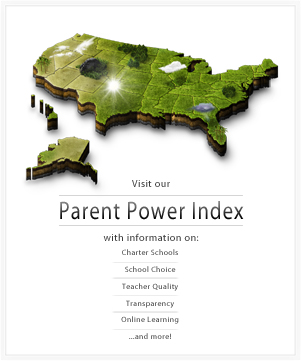Teachers Unions Face Moment of Truth
Stephanie Simon, Politico
It’s designed to be an impressive show of force: Thousands of unionized teachers plan to rally Monday in cities from New York to San Francisco to “reclaim the promise of public education.”
Behind the scenes, however, teachers unions are facing tumultuous times. Long among the wealthiest and most powerful interest groups in American politics, the unions are grappling with financial, legal and public-relations challenges as they fight to retain their clout and build alliances with a public increasingly skeptical of big labor.
“I do think it’s a moment of truth,” said Lance Alldrin, a veteran high-school teacher in Corning, Calif., who has split from his longtime union after serving for a decade as the local president.
The National Education Association has lost 230,000 members, or 7 percent, since 2009, and it’s projecting another decline this year, which will likely drop it below 3 million members. Among the culprits: teacher layoffs, the rise of non-unionized charter schools and new laws in states such as Wisconsin and Michigan freeing teachers to opt out of the union.
The American Federation of Teachers has been able to grow slightly and now represents 1.5 million workers — but because many new members are retirees or part-timers who pay lower dues, union revenue actually fell last year, by nearly $6 million, federal records show.
Moreover, the membership of the NEA and AFT overlaps considerably; some 663,000 workers show up on both rolls because their locals maintain dual affiliations. That double counting inflates perceptions of the teacher lobby’s combined strength. Total union membership isn’t 4.5 million — it’s 3.8 million.
The unions and their affiliates still control huge resources. They collectively bring in more than $2 billion a year, most of it from member dues. Yet there are signs of financial strain. The NEA has cut spending by 12 percent in the last two years, in part by reducing its staff. And after years of posting surpluses, the AFT has been running deficits. It wrapped up the most recent fiscal year owing $3.7 million on its line of credit, up from $916,000 the previous year, according to records filed with the U.S. Department of Labor. (AFT officials point out that’s still just a fraction of the union’s $155 million general fund budget.)
The unions also face threats to their public image.
Former U.S. Solicitor General Theodore Olson expects to go to trial in California next month with an audacious lawsuit that aims to overturn teacher job protections, such as tenure, that unions helped muscle into state law.
His work in the courtroom will be paired with a broad PR campaign painting the teachers unions as obstructionists who protect their members at all costs.
Olson has gathered hair-raising stories about a small number of teachers who sexually harassed students, refused to plan lessons, appeared on campus under the influence, yet held onto their jobs for years because of union-backed job protections. Exhibit A: The Los Angeles Unified School District, which spent a decade and $3.5 million trying to dismiss seven teachers for poor performance — and only succeeded in ousting four. Rather than attempting to fire Mark Berndt, a veteran teacher who pleaded guilty last month to lewd acts with his students, the district paid him $40,000 to resign.
Union leaders say that Olson is distorting the picture by focusing on a few bad apples. “Parents will see through that,” NEA President Dennis Van Roekel said.
But Olson says he intends to use tactics borrowed from his successful fight to overturn California’s ban on same-sex marriage – plus funding from Silicon Valley entrepreneur David Welch – to make sure he wins not just in the legal arena, but “in the court of public opinion.”
More bad press for unions looms on the East Coast, where former CNN anchor Campbell Brown has financed TV ads and a relentless social media campaign accusing the unions of protecting New York City teachers who sexually harass students. She’s got some vivid, cringe-inducing examples – and she’s planning to kick the campaign into high gear this winter.
Union leaders say they don’t protect bad teachers, just seek to ensure due process. And they brush off the negative publicity as a political ploy that won’t gain traction. The American public, they say, is much more interested in talking about scrapping high-stakes testing, broadening the curriculum, reducing class sizes and spreading resources equitably — all issues that unions have championed.
(Also on POLITICO: Little-known higher ed nominees raise eyebrows)
In the struggle for “hearts and minds,” unions are winning, AFT President Randi Weingarten said.
It’s not clear, however, that those alliances are deep or durable: Support for labor unions in general has fallen steadily, dipping below 50 percent for the first time in 2012 before rebounding slightly this year, Gallup polls find. Only 32 percent of Americans expressed a positive view of teachers unions (and another 25 percent were neutral) in a poll last year by the journal Education Next.
To be sure, unions still have the funding and the foot soldiers to be power players. The NEA and AFT spent more than $40 million last year on federal lobbying and electoral politics, according to the Center for Responsive Politics, plus tens of millions more in the states. And they can still splurge when it’s important to them: The AFT bought $1.2 million worth of TV, radio and print advertising this weekend to promote the National Day of Action.
But labor analysts say it’s clearly a new environment for teachers unions. “They’re much more on the defensive now,” said Katharine Strunk, an education professor who studies labor at the University of Southern California.
“This is a very, very challenging time for unions,” said John Logan, a professor of labor history at San Francisco State University.
Among the challenges: Dissent from within.










